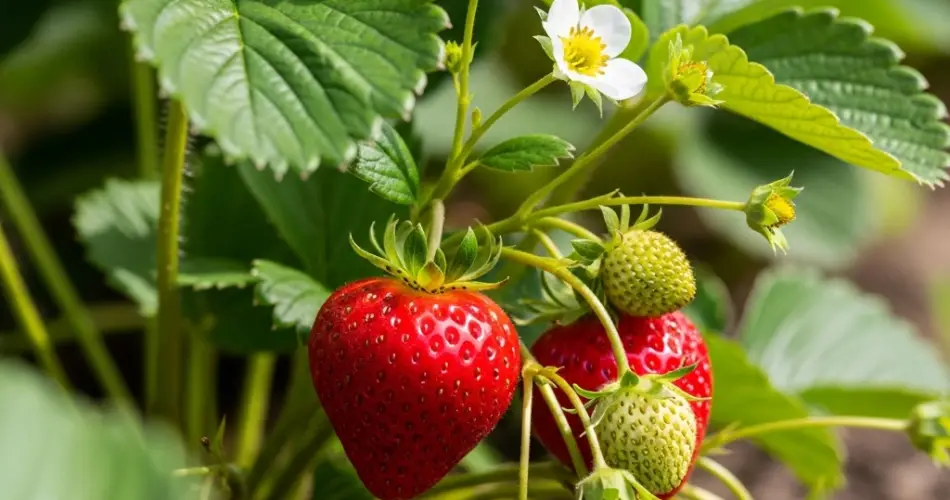Strawberries are a favorite for home gardeners thanks to their sweet, juicy flavor and compact growing habits. However, many growers struggle to get consistently high yields or vibrant, healthy plants. If you want your strawberries to thrive, there’s one small but powerful secret: add just one tablespoon of a natural booster, and your plants will respond almost overnight.
This simple addition can significantly improve root development, flowering, and fruit production, leading to lush strawberry beds bursting with berries.
The Secret Ingredient: Wood Ash
The “magic” tablespoon that sends strawberry plants into overdrive is wood ash — a humble byproduct of fireplaces or fire pits. Wood ash contains potassium, calcium, and a host of trace minerals that plants need to grow strong and bear fruit. When applied correctly and in the right amount, this natural material can transform your strawberry patch into a fruit-producing powerhouse.
Why Wood Ash Works Wonders for Strawberries
Strawberries love slightly acidic to neutral soil (pH 5.5–6.8), and they respond very well to potassium and calcium — two major components of wood ash.
-
Potassium (K) helps with overall plant vigor, disease resistance, and especially fruit development. It ensures strawberries grow plump, sweet, and full of flavor.
-
Calcium (Ca) strengthens cell walls and promotes healthy root systems. It also helps prevent common problems like blossom end rot and leaf burn.
-
Trace Minerals like magnesium, phosphorus, and zinc in wood ash contribute to overall plant health and flower production.
With just one tablespoon per plant, you’re providing a fast-acting, natural nutrient boost.
How to Apply Wood Ash to Strawberry Plants
-
Use Clean, Untreated Ashes: Only use ash from clean, untreated hardwoods. Never use ash from painted, varnished, or chemically treated wood, as it can contain harmful toxins.
-
Wait Until the Soil Is Ready: Apply the ash in spring, just as new growth begins. This timing ensures the nutrients are available when the plant starts developing flowers and fruit.
-
How Much to Use: Apply one tablespoon of wood ash per strawberry plant. Sprinkle it in a ring around the base of the plant, a few inches away from the crown to avoid burning the delicate roots.
-
Water In: After applying the ash, water the soil well. This helps dissolve the minerals and move them into the root zone, where the plant can absorb them.
-
Repeat Once or Twice Per Season: You can reapply a small amount of ash once more mid-season if needed, but avoid overdoing it. Excessive ash can raise soil pH too much and interfere with nutrient uptake.
Benefits You’ll See
With proper use, gardeners often notice visible changes in just a few days to a week:
-
Greener Leaves: Plants look healthier and more vibrant due to improved nutrient availability.
-
More Flowers: Strawberry plants start forming more blossoms, many of which turn into fruit.
-
Bigger, Sweeter Berries: With more potassium available, berries become larger and sweeter.
-
Stronger Plants: Calcium from the ash helps build resilience against pests and fungal issues.
Other Ways to Support Strawberry Growth Naturally
While wood ash provides a powerful boost, combining it with other good gardening practices ensures even better results:
-
Mulch Around Plants: Use straw or shredded leaves to conserve moisture and prevent weeds.
-
Keep the Soil Moist: Strawberries need consistent watering, especially during flowering and fruiting.
-
Feed with Compost: Along with the minerals from wood ash, well-rotted compost provides balanced nutrients and improves soil structure.
-
Trim Runners (if needed): Removing excess runners helps the plant focus its energy on producing fruit.
A Word of Caution
-
Test Soil pH if Possible: If your soil is already alkaline, adding ash could raise the pH too much. A simple soil test kit can help you determine if your soil needs the adjustment.
-
Don’t Mix with Nitrogen Fertilizers: Mixing wood ash with high-nitrogen fertilizers can release ammonia gas. Apply them separately to avoid this reaction.
-
Store Ash Properly: If you collect ash for later use, store it in a sealed, dry container to prevent moisture and nutrient loss.
Other Plants That Love Wood Ash
Wood ash isn’t just great for strawberries. You can also use it (in moderation) on:
-
Tomatoes
-
Peppers
-
Garlic
-
Onions
-
Carrots
-
Beets
-
Roses
-
Lilacs
These plants also benefit from the potassium and calcium boost wood ash provides.
Final Thoughts
If you’re looking for an easy, natural way to boost your strawberry plants, just one tablespoon of wood ash can make a world of difference. This forgotten garden remedy is rich in essential nutrients that improve flowering, fruiting, and overall plant strength. With proper use, your strawberry plants will grow faster, produce more fruit, and reward you with a harvest that just might leave you surprised.
Try this simple tip and watch your strawberries go crazy — in the best way possible!



